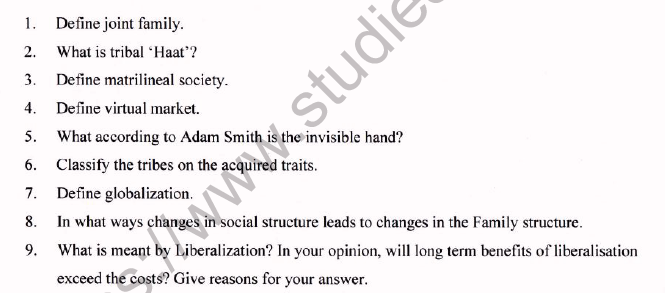
VALUE POINTS
1. Extended family where that is more than one couple and after more than two generations living together.
2. The weekly haat is a common sight in rural and even urban India. In hilly and forested areas (especially those inhabited by adivasis), where settlements are far-flung, roads and communications poor, and the economy relatively undeveloped, the weekly market is the major institution for the exchange of goods as well as for social linter course.
3. Societies where women inherit property from their mothers but do not exercise control over it, nor are they the decision makers in public affairs.
4. A market that exists electronically and conducts transactions via computers telecommunication media. It is also known as paperless market.
5. There seems to be some sort of an unseen force at work that converts what is good for each individual into what is good for society. This unseen force was called ‘the invisible hand’ by Adam Smith. Smith
used the idea of the ‘invisible hand’ to argue that society overall benefits when individuals pursue their own self-interest in the market, because it stimulates the economy and creates more wealth.
6. Acquired Trait:
a. Mode of livelihood.
b. Incorporation into the Hindu community.
(Explain these points with examples)
7. A period in which the world is becoming increasingly interconnected — not only economically but also culturally and politically. The term globalisation includes a number of trends, especially the increase in international movement of commodities, money, information, and people, as well as the development of technology
8. This internal structure of the family is usually related to other structures of society.
The composition of the family and its structure thereby changes. And these changes can be understood in relation to other changes in society. The family (the private sphere) is linked to the economic, political, cultural, and educational (the public) spheres.
Sometimes these changes occur Accidentally, as when a war takes place or people migrate in search of work. Sometimes these changes are purposely brought about, as when young people decide to choose their spouses instead of letting elders decide. Or when same sex love is expressed openly in society.
9. Liberalisation is the process whereby state control over economic activities are minimized and left to the market forces to decide. In general, it is process of making laws more liberal and loosening of government rules and regulation on capital labour and trade, privatization of public sector enterprises selling government around companies to private companies, a reduction in tariffs and import duties so that foreign goods can be imported more easily.
• It includes privatization of public sector enterprises.
• It allows easier access for foreign companies to set up industries in India.
• This is also known as marketisation or market based process to solve economic, social or political problems.
The changes that have been made under the liberalisation programme have stimulated economic growth and opened up Indian markets to foreign companies. For example, many foreign branded goods are now sold, which were not previously available. Increasing foreign investment is supposed to help economic growth and employment. The privatisation of public companies is supposed to increase their efficiency and reduce the government’s burden of running these companies. However, the impact of liberalisation has been mixed. Many people argue that liberalisation and globalisation have had, or will have, a negative net impact on India – that is, the costs and disadvantages will be more than the advantages and benefits. Some sectors of Indian industry (like software and information technology) or agricultur (like fish or fruit) may benefit from access to a global market, but other sectors (like automobiles, electronics or oilseeds) will lose because they cannot compete with foreign producers.
Please click on below link to download CBSE Class 12 Sociology Worksheet Set F

